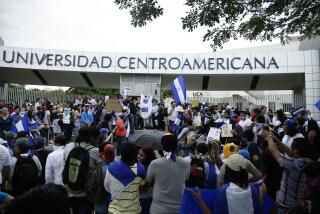Military College Is First to Offer On-Campus Training for Peace Corps
NORTHFIELD, Vt. — Cadet Julianna Klejnot is out of uniform this day at Norwich University, and that is unprecedented in the 168 years of the oldest private military college in the United States.
Instead of her standard green skirt and shirt, she is wearing jeans and a pink cotton warm-up jacket. She is one of three cadets on a work detail to winterize a widow’s home off campus.
The cadets are a Peace Corps squad that has invaded the military college in a pilot program to prepare juniors and seniors for tours of duty with the Peace Corps or other volunteer relief agencies.
The program, the only one of its kind in the nation, is an alternative to campus ROTC and eventual military service.
Norwich and Peace Corps officials said they hope that other colleges will follow suit, and that the federal government will join the schools and sponsor the training as it has supported ROTC on 400 campuses. Other schools already have made inquiries to Norwich, they said.
A bill pending in Congress would allocate $5 million a year for five years to enable the Peace Corps to test the program at other schools. Norwich went ahead and added the Peace Corps to its curriculum last September, and will foot the cost itself.
Doubling Volunteer Force
The Peace Corps is campaigning to double its volunteer force to 10,000 by 1992 and has challenged colleges to find ways to help.
“Because of programs like the one in Norwich, we will be able to reach that goal,” said James C. Flanigan, Peace Corps press officer in Washington.
Lewis Greenstein, the Peace Corps liaison with universities, called the Norwich pilot program a promising model and the forerunner of a federally sponsored plan to encourage undergraduates to enter a volunteer service. Still, he acknowledged “the irony of a military school preparing people for the Peace Corps.”
The impetus came from the university president, W. Russell Todd, a retired general whose 32 years in the Army included combat duty in Vietnam. Todd, his son and his father are all graduates of Norwich.
“The most exciting thing about it is the way people perceive Norwich University,” said Todd. “They’ve seen us as a bunch of Rambos, and when we’ve expressed our mission in terms of the Peace Corps, we’ve had a very, very positive reaction from some people.”
Two Campuses Combined
Norwich has two campuses and two student bodies, one military and one civilian. The Peace Corps program has drawn students from each.
The Military College was founded in 1819, and the murals and plaques on its walls honor its heroes from the Mexican War of 1847 to Vietnam.
The civilian campus, Vermont College, eight miles away in Montpelier, was founded in 1834 as a Methodist seminary.
It was merged with Norwich University in 1972 to allow a wider academic program and more opportunity for expansion. The military college has an enrollment of 1,300 cadets, including 81 women. The civilian college has 900 students.
Todd said he had been looking for a way to give the civilian student body a sense of national service, and when his wife, Caroline, came back from a conference on volunteerism last summer, she told him: “I found what we’ve been looking for.”
She had heard Loret Miller Ruppe, director of the Peace Corps, report on a proposal of the Rev. Theodore M. Hesburgh, president emeritus of the University of Notre Dame. Hesburgh had suggested that the federal government devise an ROTC-type preparation program that colleges could offer undergraduates.
Prototype Developed
“So, rather than wait for the federal government to devise a program, we decided we’d experiment,” said Todd. “When I discussed it with the Peace Corps, they were fascinated.”
What surprised Todd was that the Peace Corps officials were not nearly as interested as he was in putting the program on the civilian campus. They wanted it on the military campus because of the cadet corps’ physical and leadership training. A compromise was struck to make it available on both campuses.
Only four students are enrolled in the first class, three of whom had been in ROTC on the military campus and one from the civilian campus. Todd said the goal is to have 60 students two years from now.
The four students now enrolled are not sure whether they will go into the Peace Corps. The trainees are not committed to duty after graduation and the Peace Corps is under no obligation to accept any of them.
As an incentive, Norwich is offering seniors low-interest loans of up to $5,000 that will be written off if they serve two years in the Peace Corps.
Military Options
Military students at Norwich must take four years of ROTC, but service after graduation is optional. Graduates who agree to accept a commission for active service are paid $100 a month in their last two years at the college. Otherwise, they receive no monthly stipend while in school and go into the reserves after graduation.
Tuition, fees and room and board run $12,500 a year at Norwich.
Klejnot, a 21-year-old junior biology major from Maine, initially enrolled in Air Force ROTC because she wanted to see what the military was like. After 2 1/2 years, she decided she didn’t want to be committed to a regulated life in the military.
“The Peace Corps option was available so I decided to see what it was like,” she said.
Even though she dropped ROTC, she still has to wear her uniform and attend three formations a day, a requirement for all cadets on the military campus.
More to Read
Sign up for Essential California
The most important California stories and recommendations in your inbox every morning.
You may occasionally receive promotional content from the Los Angeles Times.










